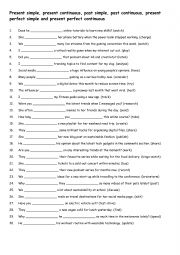|
Printables |
PowerPoints |
Online exercises |

|
A1+-A2 Practice with: present simple, present continuous, past simple & going to 1
Students should practise present simple, present continuous, past simple, and going to because these tenses are essential for expressing habits, actions, past events, and future plans. They enable clear and confident communication in everyday situations, help build fluency, and provide a strong foundation for learning more advanced grammar. Masteri...
Level: elementary
Age: 8-100
Type:
Downloads: 112
|

|
A1+-A2 Practise with 12 mixed prepositions 1
Students need to learn prepositions like at, by, for, from, in, into, of, on, out of, to, up, and with because these prepositions are essential for constructing clear and accurate sentences in English. Prepositions show relationships between words, such as location ("at the park"), direction ("into the room"), time ("by 5 p.m."), and cause ("for hi...
Level: elementary
Age: 8-100
Type:
Downloads: 130
|

|
A1+-A2 Practise with 13 mixed prepositions 2
Students need to learn prepositions like at, by, for, from, in, into, of, on, out of, to, up, and with because these prepositions are essential for constructing clear and accurate sentences in English. Prepositions show relationships between words, such as location ("at the park"), direction ("into the room"), time ("by 5 p.m."), and cause ("for hi...
Level: elementary
Age: 8-100
Type:
Downloads: 117
|

|
A1+-A2 Practise with 15 mixed prepositions 1
Mastering prepositions is vital for expressing relationships between ideas in English. They help indicate time, place, direction, and cause, making sentences more precise and meaningful. By practising with common prepositions like: about, at, by, for, from, in, into, of, on, out of, over, through, to, up, and with, students enhance their ability to...
Level: elementary
Age: 8-100
Type:
Downloads: 110
|

|
A1+-A2 Practise with 15 mixed prepositions 2
Mastering prepositions is vital for expressing relationships between ideas in English. They help indicate time, place, direction, and cause, making sentences more precise and meaningful. First, students need to familiarise themselves with the 15 prepositions and their use. Then they read the sentences to work out which preposition is needed to comp...
Level: elementary
Age: 9-100
Type:
Downloads: 107
|

|
A1+-A2 Practise with 15 mixed prepositions 3
First, students need to familiarise themselves with the 15 prepositions and their use. Then they read the sentences to work out which preposition is needed to complete the gap-fill. Each tense is used 2 times! Answers on page 2
Level: elementary
Age: 8-100
Type:
Downloads: 112
|

|
A1+-A2 Practise with 15 mixed prepositions 4
First, students need to familiarise themselves with the 15 prepositions and their use. Then they read the sentences to work out which preposition is needed to complete the gap-fill. Each preposition is used 2 times! Answers on page 2
Level: elementary
Age: 8-100
Type: worksheet
Downloads: 111
|

|
A1+-A2 Practise with comparatives and superlatives 1
Students should learn comparatives and superlatives as they are essential for effective communication, allowing them to describe differences and extremes clearly. These structures enhance critical thinking by enabling comparison and evaluation, which are vital for forming opinions and writing arguments. Additionally, they are frequently used in eve...
Level: elementary
Age: 8-100
Type:
Downloads: 120
|

|
A1+-A2 Practise with comparatives and superlatives 2
Students read the sentence and complete the sentence with the correct form of the given adjective in (). Each form is used 13 times! Answers on page 2.
Level: elementary
Age: 8-100
Type:
Downloads: 105
|

|
A1+-A2 Practise with comparatives and superlatives 3
Students read the sentence and complete the sentence with the correct form of the given adjective in (). Each form is used 13 times! Answers on page 2.
Level: elementary
Age: 8-100
Type:
Downloads: 102
|
|
|
|
|












